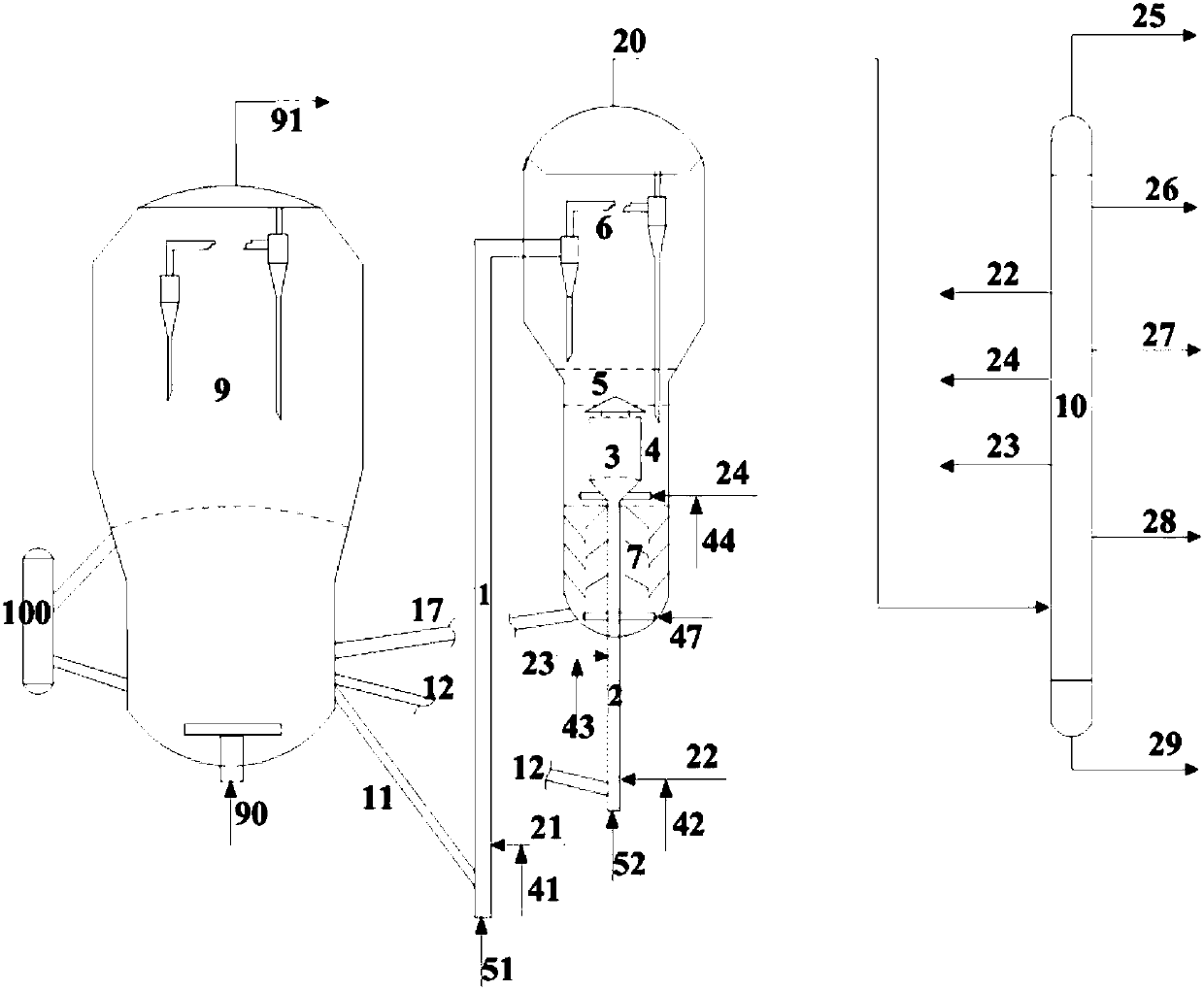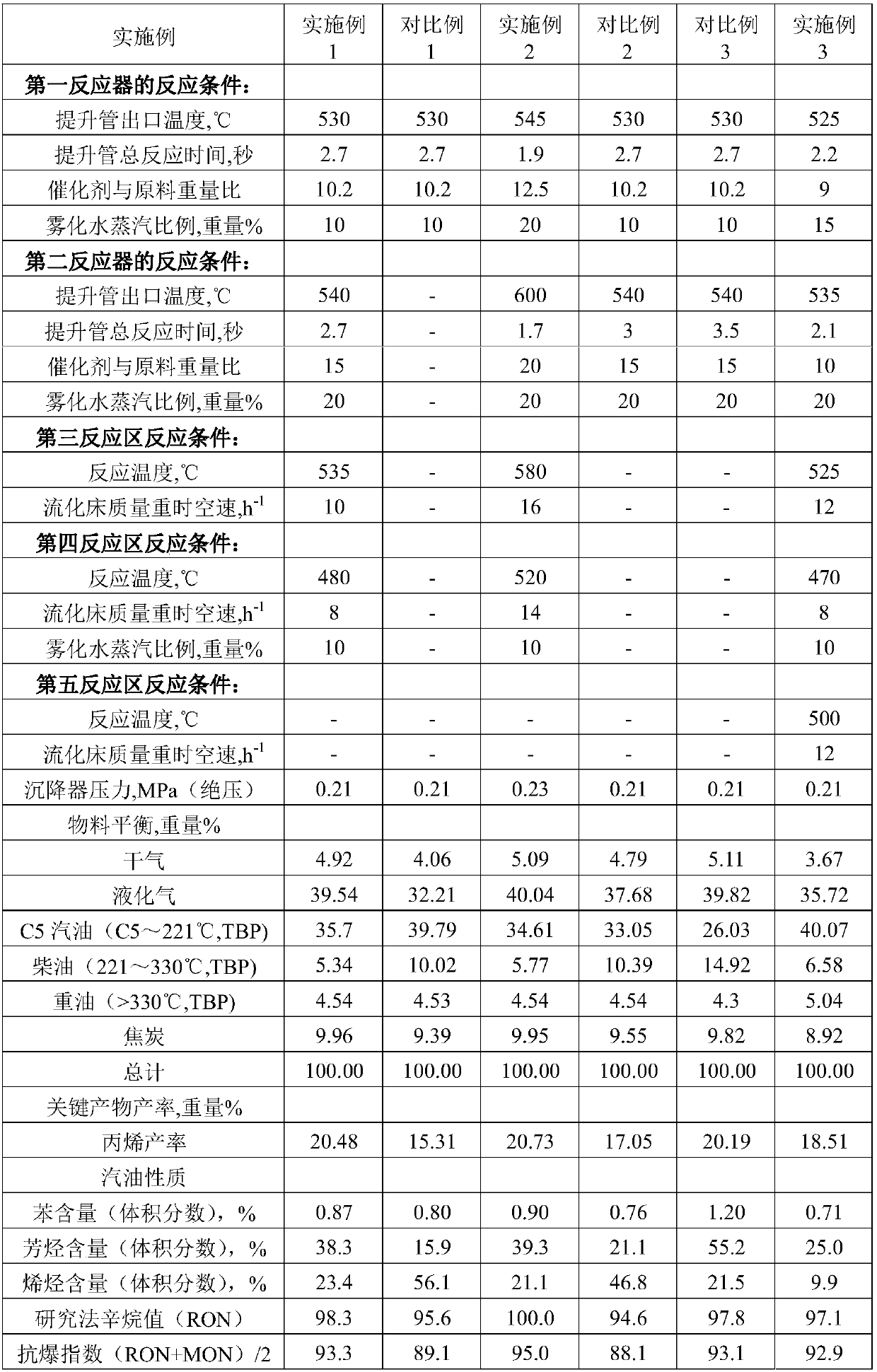Catalytic conversion method for high-yield production of propylene and improvement of quality of light oil, and system for catalytic conversion method
A catalytic conversion method and technology for light oil products, which are applied to the catalytic conversion of multi-producing propylene and improving the quality of light oil products and the system field used for the same, can solve problems such as inability to ensure favorable guarantees.
- Summary
- Abstract
- Description
- Claims
- Application Information
AI Technical Summary
Problems solved by technology
Method used
Image
Examples
Embodiment 1
[0158] Example 1 is used to illustrate the effect of catalytically converting heavy hydrocarbon oil to increase the production of propylene and improve the quality of light oil products provided by the present disclosure.
[0159] Experiments were carried out with a medium-sized plant for continuous reaction-regeneration operation with five reactors, the first of which was a riser with an internal diameter of 16 mm and a height of 3800 mm. The second reactor was a riser reactor with an inner diameter of 16 mm and a height of 3200 mm. The third reactor is a fluidized bed with an inner diameter of 64 mm and a height of 300 mm. The outlet of the riser of the second reactor is connected with the bottom of the fluidized bed of the third reactor. The fourth reactor is an annular fluidized bed, located outside the third reactor, with an outer diameter of 120 mm and a height of 300 mm. The fifth reactor is a fluidized bed, located directly above the third reactor and the fourth reac...
Embodiment 2
[0162] Example 2 is used to illustrate the effect of catalytically converting heavy hydrocarbon oil to increase the production of propylene and improve the quality of light oil products provided by the present disclosure.
[0163] The reaction apparatus that adopts is with embodiment 1. Raw material, main experimental procedure are the same as embodiment 1, and difference is that the raw material nozzle at the bottom of the second reactor riser is the starting point, and the effective length of the riser is defined as 100% along the flow direction of the raw material, and the light end fraction ( Distillation range (initial boiling point ~ 57 ℃) is injected from the starting point of the second reactor riser, and heavy distillate components (distillation range is 178 ℃ ~ 253 ℃) are injected from 70% of the downstream of light distillate components (that is, heavy distillate group The length from the injection position of the fraction to the outlet of the riser of the second re...
Embodiment 3
[0174] Example 3 is used to illustrate the effect of catalytically converting heavy hydrocarbon oil to increase the production of propylene and improve the quality of light oil products provided by the present disclosure. The reaction apparatus that adopts is with embodiment 1. In this embodiment, the fifth reactor is used, and the reaction oil gas from the third reactor and the fourth reactor is further introduced into the fifth reactor for further reaction.
[0175] The regenerated catalyst with a temperature of about 650°C enters the bottom of the riser of the first reactor through the inclined pipe of the regenerated catalyst, and flows upward under the action of the pre-lift steam. Heavy hydrocarbon oil feedstock (see Table 2 for main properties) is heated to about 350°C in a preheating furnace, mixed with atomized water vapor, sprayed into the first reactor through the feed nozzle, and catalyzed by contact with the hot regenerated catalyst conversion reaction. The reac...
PUM
 Login to View More
Login to View More Abstract
Description
Claims
Application Information
 Login to View More
Login to View More - R&D
- Intellectual Property
- Life Sciences
- Materials
- Tech Scout
- Unparalleled Data Quality
- Higher Quality Content
- 60% Fewer Hallucinations
Browse by: Latest US Patents, China's latest patents, Technical Efficacy Thesaurus, Application Domain, Technology Topic, Popular Technical Reports.
© 2025 PatSnap. All rights reserved.Legal|Privacy policy|Modern Slavery Act Transparency Statement|Sitemap|About US| Contact US: help@patsnap.com


